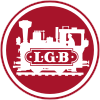This article needs additional citations for verification. (September 2008) |
 | |
| Product type | model railroad products |
|---|---|
| Owner | Märklin |
| Country | Germany |
| Introduced | 1968 |
| Previous owners | Ernst Paul Lehmann Patentwerk |
| Website | lgb.com |

LGB stands for Lehmann Gross Bahn - the "Lehmann Big Train" in German. Made by Ernst Paul Lehmann Patentwerk in Nuremberg, Germany, since 1968[1] and by Märklin since 2007, it is the most popular garden railway model in Europe, although there are also many models of U.S. and Canadian prototypes.[2] LGB caused a revival of garden model railroading in the United States when it was introduced.[2] LGB is sold in North America through Wm. K. Walthers, who took over from Ernst Paul Lehmann's subsidiary, LGB of America, when Märklin bought the LGB assets. Most of the European prototypes were manufactured in Germany, while much of the North American rolling stock was made in China. Production was later moved to Hungary.
LGB trains are responsible for introducing "G" scale to model railroading.[1] The scale ratio used by LGB is nominally 1:22.5,[3] yet many dimensions are often changed to allow operation on very tight R1 curves. American prototypes especially suffer from this. Other G-scale (and Gauge 1) manufacturers produce products that range from 1:20 to 1:32,[4] and for the most part, all use the same track and are compatible with one another. Though they can all run on the same track (45 mm gauge), models representing narrow-gauge versions of trains or locomotives would not normally be run together with models of larger full-scale vehicles. To fit the same standard track the latter must be built using different scales; for example, 1:22.5 scale passengers and/or train crew are somewhat oversized when displayed in proximity with 1:32 models. Though the models may be physically compatible, many people choose a preferred style or era, and pick one ratio (in the range of 1:20.3 to 1:32) for all of their models.
The first loco made under the LGB brand was a model of a small Austrian 0-4-0 named "Stainz", in the LGB logo. It continued in production in 2021,[5] although with a sound system and other mechanical differences to the original 1968 model. Most garden railway enthusiasts have at least one example of a Stainz in their collection as it tends to be a robust loco with good pulling power.
- ^ a b Souter, Gerry; Souter, Janet (2002). Modern toy trains. St. Paul, Minn.: MBI. pp. 35. ISBN 978-0-7603-1179-0.
- ^ a b Johnson, Kent R. (2002). Garden railroading: getting started in the hobby. Waukesha, WI: Kalmbach Books. p. 5. ISBN 978-0-89024-369-5.
- ^ Johnson, Kent R. (1998). Basic Model Railroading: Getting Started in the Hobby (Model Railroader Books). Kalmbach Publishing Company. p. 7. ISBN 978-0-89024-334-3.
- ^ A. Grams, John (1999). Toy train collecting and operating: an introduction to the hobby. Waukesha, WI: Kalmbach Books. ISBN 978-0-89778-447-4.
- ^ "(Products) Stainz - Gauge G (Schmalspur) - Article No. 20214". LGB. Retrieved 14 January 2021.